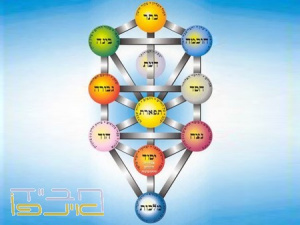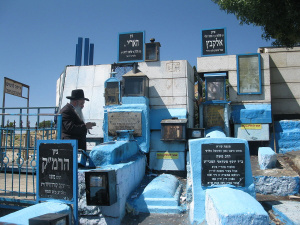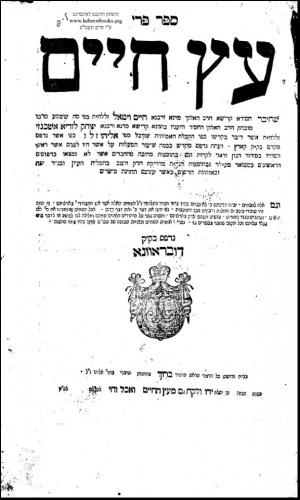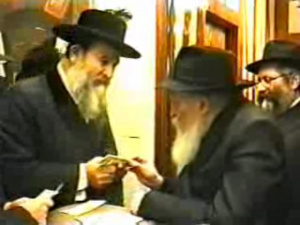Kabbalah

Kabbalah is the secret part of Torah, also called Toras HaSod (the Secret Torah), Toras HaNistar (the Hidden Torah), or Pnimiyus HaTorah (the Inner Torah). Kabbalah deals with the relationship between Hakadosh Baruch Hu and the world, the order of spiritual worlds' descent, the Sefiros and angels, and explains the inner meaning of Torah verses and mitzvos. Kabbalah has a tremendous influence on Jewish spiritual life. Among other things, Kabbalah's influence is evident in halachos, customs, and the prayer text of most Jewish circles, as well as on the Chassidic movement and teachings, mussar literature, and more.
Throughout the generations, Kabbalah was studied by select individuals, and most Torah scholars did not engage in it. There are many reservations, both in halacha and in Kabbalah itself, about studying this Torah for those who are not spiritually worthy. The study of Kabbalah became more widespread in the time of the Arizal, who wrote: "Specifically in these later generations, it is permitted and a mitzvah to reveal this wisdom."
Toras HaChassidus, revealed by the Baal Shem Tov, includes many foundations from Kabbalah, and many sections in Chassidic maamarim explain Kabbalistic concepts. However, the Chassidic leaders did not encourage systematic study of Kabbalah for the masses, but rather explained that through learning Chassidus one also fulfills the obligation to study Kabbalah, and moreover, this study ensures the learner won't err in understanding Kabbalistic concepts.
History of Kabbalah[edit | edit source]
Throughout the generations, Kabbalah was transmitted, as its name implies, through receiving from person to person. Many Jewish leaders knew it, though we don't know about all of them, since engagement in these matters was kept secret. The first known book in Kabbalah is Sefer Yetzirah, attributed to Avraham Avinu (though it may have been written down in later generations). Among the prophets, there are prophecies describing Hashem's glory that belong to the secret part of Torah, in the books of Yeshayahu and Yechezkel, called Maaseh Merkavah. Chazal placed severe restrictions on engaging with these secrets, and even among the Tannaim and Amoraim, not all engaged with them.
In the Period of the Tannaim[edit | edit source]
There were several Tannaim known for engaging in Toras HaSod. Among them were Rabbi Nechunya ben Hakanah, to whom several works in Toras HaSod are attributed: Sefer Hakanah, Sefer HaBahir, Sefer HaPliah, and Sefer HaTemunah; as well as Rabbi Yishmael and Rabbi Akiva, to whom Pirkei Heichalos and others are attributed. The central figure among the Tannaim who engaged in Toras HaSod was Rabbi Shimon bar Yochai, who together with his son Rabbi Elazar and other Tannaim from his group composed the Zohar. This book was hidden for over a thousand years (though some Geonim and Rishonim may have known it), and was revealed in the first century of the sixth millennium by the Kabbalist Rabbi Moshe de Leon. Since its publication, the book became a foundational text of Kabbalah, and many Kabbalistic writings are based on it.
In the Period of the Rishonim[edit | edit source]
At the end of the Geonic period, Rabbi Aharon ben Shmuel HaNasi, a sage from Bavel who migrated to Italy, is known to have transmitted Toras HaSod to Italy. Rabbi Moshe ben Kalonymus received the secrets of Kabbalah from him, and after his family, the Kalonymus family, moved from Italy to Ashkenaz - a tradition of transmitting Toras HaSod developed among Ashkenazic scholars, up to Rabbi Shmuel HaChassid and his son Yehudah HaChassid, as well as Rabbi Elazar of Worms, the Rokeach, who established a circle of "Chassidim" who engaged in this Torah (now known as "Chassidei Ashkenaz").
Another circle of Kabbalists during the period of the Rishonim was in Provence. Among them, Rabbi Avraham ben David of Posquières (the Raavad of the Hasagos) was famous, who transmitted this Torah to his son, the Kabbalist Rabbi Yitzchak. Through Rabbi Yitzchak, who moved to Spain, Kabbalah was also transmitted there, and many Spanish scholars engaged in this wisdom. The most famous among them was the Ramban, as well as Rabbeinu Bachya ben Asher, Rabbi Peretz HaKohen author of "Maarechet HaElokut," the Rashba, and others.
The Rebbe Maharash told his son, the Rebbe Rashab, during one of their lessons in Moreh Nevuchim, that he had a tradition from rebbe to rebbe back to the Baal Shem Tov that the Rambam was a great Kabbalist, and the reason he didn't reveal this (even by hint, like Rashi) was because it was a dangerous time to reveal matters of Kabbalah even by hint
The Kabbalists of Tzfas[edit | edit source]
Kabbalah received extensive attention among the sages of Tzfas during the fourth century of the sixth millennium (the 1500s). Among the most famous were Rabbi Moshe Alshich, Rabbi Shlomo Alkabetz, and the Radbaz. During that period, Rabbi Moshe Cordovero, the Ramak, lived and worked, teaching many students Kabbalah. In his great work Pardes Rimonim, he organized the approaches of earlier Kabbalists, summarized and decided between them, and explained his approach to Kabbalah.

The greatest influence on the transmission of Kabbalah was Rabbi Yitzchak Luria, the Arizal, who moved from Egypt to Tzfas in 5330 (1570) and during the two years until his passing in 5332 (1572) established a group of students (called "the Arizal's cubs") to whom he transmitted his secrets. After his passing, his greatest student, Rabbi Chaim Vital, organized and arranged his teachings, and he is the primary writer of the Arizal's writings. The Arizal's system of Kabbalah spread throughout all Jewish communities and became the central approach to Kabbalah until today, among Sephardic Kabbalists, Lithuanian scholars, and Chassidim.

Despite the importance of the Ramak's Kabbalah and its great influence on Kabbalah until today, the Arizal's Kabbalah is the more primary approach. Rabbi Chaim Vital testified that after the passing of his teachers, the Ramak and the Arizal, the Ramak appeared to him and revealed that although both Kabbalistic approaches are true, nevertheless "my way is according to the simple understanding for beginners in Kabbalah wisdom, while your teacher's [the Arizal's] way is inner and primary, and even I now in heaven only study according to your teacher's way." In Chassidus it was explained that the difference between the approaches is that "the Ramak's Kabbalah deals with the Sefiros of Tohu (matters of Tohu within Tikkun itself), while the Arizal's Kabbalah deals with Tikkun"; the Ramak's Kabbalah is also true, but the Arizal's Kabbalah is absolute truth, and wherever Kabbalists disagree, the decision follows his approach.
Study of Kabbalah[edit | edit source]
The study of Kabbalah differs from the study of the revealed Torah, since in studying the revealed Torah, one understands the essence of what they're learning, but in studying Kabbalah one only knows about the existence of the concepts being learned, but doesn't understand their essence. For this reason, studying Kabbalah is similar to studying Scripture, where one can also learn without understanding.
However, halachically it's ruled that studying Kabbalah counts as part of learning Gemara, meaning learning that includes complete understanding and comprehension. The reason for this is that there are two ways of studying Kabbalah: when one learns just the main points concisely, or when one learns the concepts extensively with explanation. Learning in the first way is similar to learning Scripture, and the second to learning Gemara.
Restrictions on Studying Kabbalah[edit | edit source]
In Chazal there are restrictions on studying Pnimiyus HaTorah, and these restrictions were codified by the Rambam - that we don't teach Torah secrets except to one who has already learned much in the revealed Torah and has enough wisdom to grasp the secrets. However, these restrictions don't mean that the secret part of Torah itself is forbidden to study; the prohibition is only for people who due to their limited understanding cannot learn it. But this part itself is one of the parts of Torah and we are commanded to learn it just like any other part.
An additional caution in learning Kabbalah is not to study it independently, trying to understand things according to human logic, but only through receiving from a qualified person to person, or those who merit to receive things directly through revelations from Eliyahu and the like.
Another caution is not to engage in practical Kabbalah. The Alter Rebbe spoke against those who engage in conjuring angels for supernatural power, since there's no benefit for avodas Hashem. The Alter Rebbe even testified that he never saw people engaging in this and never saw books about it, only heard that in earlier generations they would conjure angels.
The Rebbe did not deny the truth of practical Kabbalah matters like matchmaking compatibility and palm reading, but limited the way to acquire them to learning from a teacher and not self-study. The Rebbe denied the existence of a contemporary Kabbalist specializing in these matters, and even instructed to stay away from these matters and all matters of practical Kabbalah.
Kabbalah and Chassidus[edit | edit source]
Toras HaChassidus, which was revealed by the Baal Shem Tov, includes many foundations from Kabbalah. Many Chassidic customs are based on Kabbalah, and the Chassidic prayer text follows the Arizal's version.
The Baal Shem Tov's teachings frequently quote from Kabbalah, especially from the Arizal's writings.
The Alter Rebbe's maamarim are mostly built on the simple meaning, with little Kabbalah (from Kabbalistic teachings found in books). The little that appears in his maamarim is understandable to those who have studied some Kabbalistic books, and their purpose in the maamarim is to add love and fear of Hashem to the learner.
In contrast, in the Mitteler Rebbe's maamarim, Kabbalah is not quoted at all[1].
When the Rebbe Maharash praised the maamarim of Reb Aizik of Homil, he expressed that every one of Reb Aizik's analogies has a source in Kabbalah.
In 1947, when Rabbi Tzvi Hirsh Fogelman told the Rebbe about a Kabbalist specializing in face reading and palm reading, the Rebbe responded with surprise and noted that when a Chassidic young man meets a Kabbalist, the young man should ask the Kabbalist if he knows about the concepts of Atik and Arich, and about Chassidus. The Rebbe then told Rabbi Fogelman that the Frierdiker Rebbe dealt with such Kabbalists and practical Kabbalah, and the Rebbe also inquired about the address of the Kabbalist whom Rabbi Fogelman met.
Although Chassidus includes Kabbalah and is based on it, it doesn't come as a means to explain Kabbalah. The Rebbe Rashab expressed this in his saying: "The world thinks that Chassidus is a commentary on Kabbalah. This is a mistake; Kabbalah is a commentary on Chassidus." The Rebbe explained this, saying that the purpose of Chassidus is knowledge of G-dliness and it explains in every concept the connection with Hashem's essence, while Kabbalah explains each topic as it exists in its particular place in the order of descent - in Sefiros, etc. Therefore, Kabbalah is one of the four parts of PaRDeS Torah - the "Sod" (secret) part, while Chassidus isn't a particular part but rather the inner dimension of all four parts. Thus, Kabbalah is a commentary on Chassidus, not the reverse.
For this reason, Chassidus also deals with loftier matters than those in Kabbalah. As the Alter Rebbe said when Reb Zalman of Kornitz asked him to say Chassidus on Eitz Chaim: "Zalman asks me to say Chassidic discourses on Eitz Chaim. What does Eitz Chaim deal with? With the order of descent, but we, thank G-d, deal with far higher matters." Similarly, when beginning to say Chassidus, the Alter Rebbe would say: "Kabbalah is names and revelations [of Hashem], but Chassidus is 'we will rejoice and be glad in You' - in the Essence."
At the same time, unlike Kabbalah which explains the virtues effected in the upper worlds through man's service, Chassidus specifically explains the virtue found in physical matters and service in this physical world.
One of Chassidus's additions to Kabbalah is the concept of G-d's unity, which is explained and elucidated in Chassidus but doesn't appear in Kabbalah
Learning Kabbalah Through Learning Chassidus[edit | edit source]
In the revelation of Chassidus, the possibility emerged for every Jew to study the inner part of Torah as in Kabbalah, but without the restrictions that apply to this study. Therefore, in our generation, the obligation to study Pnimiyus HaTorah, and the fulfillment of the Arizal's words that in these generations it's a mitzvah to reveal Kabbalah wisdom, applies to studying Chassidus. In many of his letters, the Rebbe bases the obligation to study Chassidus on this halachic requirement and on these words of the Arizal[2].
Two explanations are given for why specifically in recent generations Chassidus was revealed, allowing the study of Pnimiyus HaTorah without the restrictions related to Kabbalah: a) Because of the increased darkness in these generations of the footsteps of Moshiach, there is a necessity for a special power from Torah to overcome the darkness and awaken in divine service. b) Because of the approaching arrival of Moshiach when the whole world will engage in knowledge of Hashem, and there is a need to prepare for this.
Restrictions on studying Kabbalah Even in Our Times[edit | edit source]
Even in our time, after the revelation of Chassidus, the restrictions on studying Kabbalah apply to those who don't learn it through Chassidus.
The Tzemach Tzedek brings that "the Baal Shem Tov commanded not to study Kabbalistic books, because one who doesn't know how to abstract the matters from their physicality becomes very materialistic through this study, when they give form in their poor understanding to G-dliness according to particular measures." This warning applies even today to those who study Kabbalah not according to Chassidus, but those who learn according to Chassidus are protected from this concern.
Similarly, one who learns according to Chassidus is also protected from the warning against learning Kabbalah through independent methods, since our Rebbeim received it person to person from the Baal Shem Tov who received from Achiya HaShiloni, and are qualified to explain Kabbalistic concepts, unlike learning through new approaches. For this reason, the Rebbe had reservations about learning the "Hasulam" commentary on the Zohar by Rabbi Yehuda Leib Ashlag, because "as heard, he paved his own path in studying Eitz Chaim and the Zohar, and we have only the king's highway of our leaders in Toras HaChassidus."
When Rabbi Yechezkel Ashlag passed before the Rebbe during dollar distribution and asked him to sign a proclamation that all Jewish people should study Kabbalah to bring the redemption - the Rebbe responded that it's accepted in Chabad that Chabad Chassidus is built on Kabbalistic foundations, but in a method of Chochmah, Binah, Daas, and therefore one who studies Chabad teachings also learns Kabbalah. When the Rav repeated his request, the Rebbe replied that as a grandson of the Alter Rebbe, he cannot sign a note saying one needs to study Kabbalah, as it might imply that one doesn't fulfill their obligation through Chabad teachings. When the Rav brought proof from the Alter Rebbe's language that writes "the Baal Shem Tov's words according to the Arizal's Kabbalah," suggesting that learning Chassidus isn't actually Kabbalah, the Rebbe responded that since the Alter Rebbe writes explicitly in another Igeres HaKodesh, he couldn't have contradicted himself elsewhere.

Nevertheless, there were Chabad Chassidim in the past who also engaged directly in studying Kabbalah. Particularly known was the Gaon and Chassid Rabbi Levi Yitzchak Schneerson, the Rebbe's father (who wrote many books based on Kabbalah, of which only a few reached us). Also known as an expert in Kabbalah was Rabbi Menachem Zev Greenglass, who was a mashpia in Yeshivas Tomchei Temimim Montreal, Canada, and may he be separated for life, Rabbi Yitzchak Ginsburgh, head of Od Yosef Chai Yeshiva.
For Further Reading:[edit | edit source]
Menachem Bronfman, The Kabbalists and the Rebbe, Kfar Chabad Weekly Issue 1926 page 123